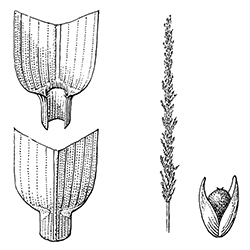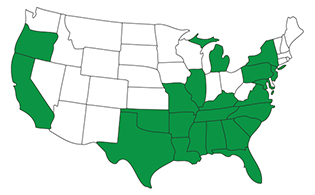

Smutgrass
Sporobolus poiretii
Smutgrass is a perennial grassy weed that is also known as Sporobolus indicus or by its scientific name, Sporobolus poiretii. This lawn weed produces seeds that are often infected by a smutty fungus, lending this plant its name.
Identify

Bunch

Hairy

Rolled
Smutgrass can be identified as an upright, tough, perennial grassy weed. Its collar is divided into two parts by the mid-vein, and its sheath is smooth and round. It also has flat blades that taper to a sharp point. This lawn weed can best be identified by its seed head, which forms a long, narrow, spike-like panicle. The seeds are often black in color due to infection by a smutty fungus—hence the name Smutgrass.
Life Cycle
This lawn weed thrives in open areas, often occurring in home lawns, pastures and along roadsides. Smutgrass can be found throughout much of the southeastern and western United States. These perennial grassy weeds can germinate and spread from seeds, but they also produce a root structure (tubers, bulbs or corms) that can birth new weeds from your lawn's surface (using stolons) or from underground (using rhizomes). Perennial grassy weeds live two or more years and have a deeper root structure that can give rise to new weeds—even if you no longer see the weeds in your lawn.

Control
Trying to control Smutgrass when relying exclusively on cultural weed control methods—such as hand-pulling lawn weeds or proper watering and mowing—are not adequate. Although these cultural control practices can help prevent the spread of Smutgrass in your lawn or landscaping when performed consistently, this grassy weed can be rather difficult to eradicate. For effective weed removal, professionally selected and applied weed control treatments are your best bet for eradication.




Facebook
X
Youtube
Copy Link
Email